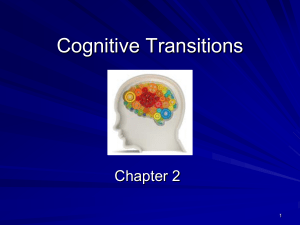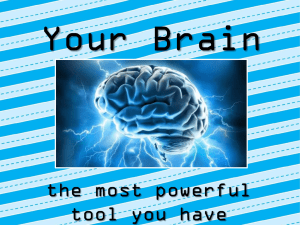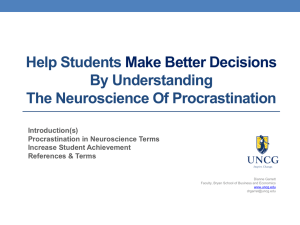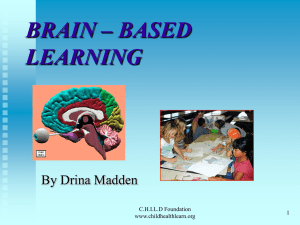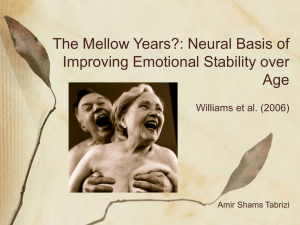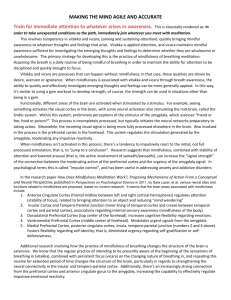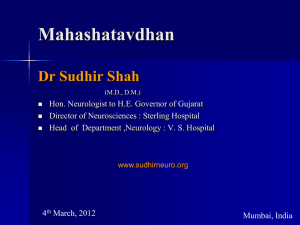prefrontal cortex
advertisement
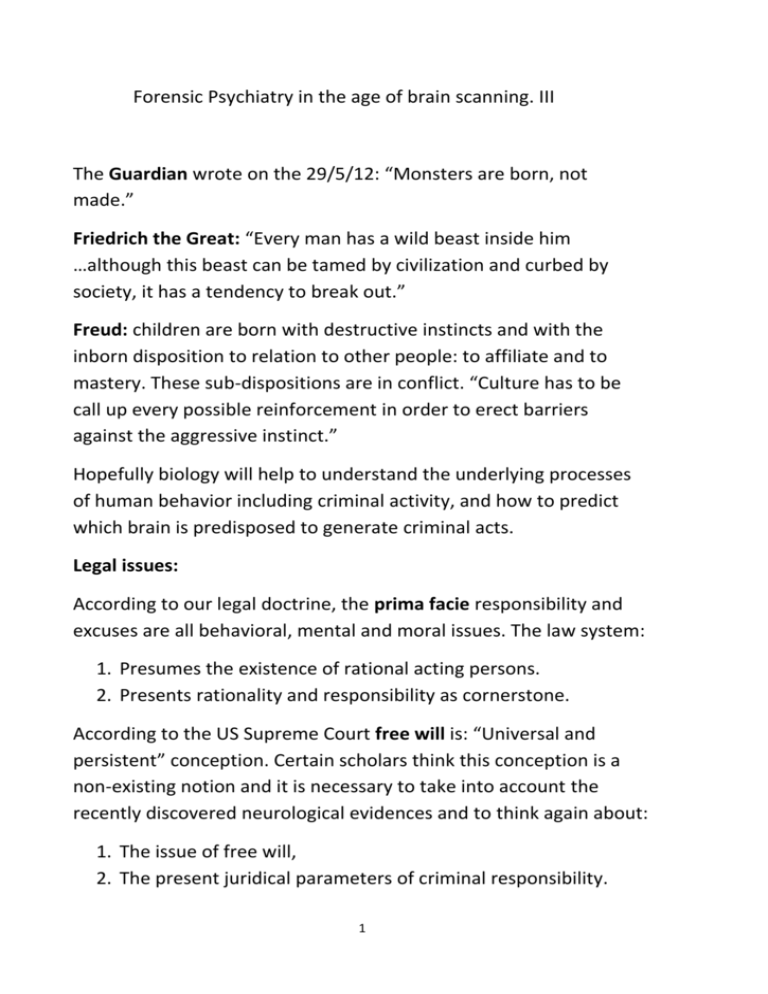
Forensic Psychiatry in the age of brain scanning. III The Guardian wrote on the 29/5/12: “Monsters are born, not made.” Friedrich the Great: “Every man has a wild beast inside him …although this beast can be tamed by civilization and curbed by society, it has a tendency to break out.” Freud: children are born with destructive instincts and with the inborn disposition to relation to other people: to affiliate and to mastery. These sub-dispositions are in conflict. “Culture has to be call up every possible reinforcement in order to erect barriers against the aggressive instinct.” Hopefully biology will help to understand the underlying processes of human behavior including criminal activity, and how to predict which brain is predisposed to generate criminal acts. Legal issues: According to our legal doctrine, the prima facie responsibility and excuses are all behavioral, mental and moral issues. The law system: 1. Presumes the existence of rational acting persons. 2. Presents rationality and responsibility as cornerstone. According to the US Supreme Court free will is: “Universal and persistent” conception. Certain scholars think this conception is a non-existing notion and it is necessary to take into account the recently discovered neurological evidences and to think again about: 1. The issue of free will, 2. The present juridical parameters of criminal responsibility. 1 Medico-legal issues: The development of brain scanning methods enriched our ability to produce biological evidences of existing mental deficiencies, based on organic brain etiology. The fact that behavior had causes does not reduce the person’s responsibility in the eyes of the law. According to Morse, “Brains are not hold responsible. Acting people are”. Gazzinga and Steven: “Neuroscience will never find the brain correlate of responsibility, because that is something we ascribe to humans and not to brains.” At present we do not believe that our neuroscientific knowledge can introduce fundamental changes in legal doctrines applied today. Neuroscience is in a non-mature state to offer legally relevant data. Neuroscientists are able to: 1. Advice that an individual was acting in a certain pathological state or way. 2. Offer an approach to legal procedures, based on the concept of “alterity” of people who commit crime and are biologically different. 3. Neuroscientists can speak about increased likelihood of a certain behavior according to his group-adherence. 4. To point to legally relevant causal possibilities of mental dysfunction, related to cerebral pathology. Any brain abnormality or dysfunction may be source of forensic concern and should be weight from the integrated neurobiological, behavioral and psycho-social perspective. The law is interested to 2 know, which of the antecedents or causes allow legal excuse or mitigation. Neurosciences and neuroimaging already found their way to the Courts and play an important role as defense evidence in several issues, such: 1. Diminished capacity. (negation of mens rea) 2. Mitigation. (partially excused responsibility) These situations permit the accused to present evidence of mental abnormality. Within Forensic Psychiatry there is an increasing neuroscientific interest, because it promises biologically based explanations of human conduct. The main problem is, that there are normal people with abnormal brain scan, and violent irrational people with normal brain functioning. There are various brain pathologies, but they are not always the basis of deviant behavior. It is an empirical data, but not the cause of certain behavior. Practical applications of the neuroscientific achievements which have impact on law: 1. The age of responsibility, this is too low. In the US in 2005 the Supreme Court ruled that it is not constitutional to execute adolescents under the age of 18. 2. The use of brain imaging to assess future risk of dangerous behavior and reoffending. 3. Whether to continue detention or prevent release from custody in order to protect society. 4. Providing evidence of capability to profit from therapeutic and rehabilitation techniques. 3 5. 6. 7. 8. 9. Mitigation of culpability. Evidence of capacity to make a will. fMRI-based lie detector. Personality change in wake of brain damage. Diagnostic assistance in case of Shaken Baby and Nonaccidental Head Injury Syndromes. The neuroscientical forensic and clinical research methods use neuroimaging technology, which is a relatively recent method, therefore in many aspects problematic: 1. Whether neurosciences can help courts to decide about criminal responsibility? 2. Whether the discoveries of neurosciences are able to undermine the contemporary thinking about responsibility, and challenge the legal concept of responsibility? 3. Whether the evidence of developmental or injury induced brain pathology means a reduced responsibility, or it means a longer prison sentence? 4. Whether neuroscientific evidences are able predicting what brain activity correlates with the risk of criminal recidivism? 5. Brain imaging for forensic purposes is in experimental phase. 6. Brain scan experiments and studies use low number of experimental and control subjects. 7. The scanning procedures are not standardized and validated. 8. Statistical difficulties in using group brain data to interpret individual brain scan results. 9. There is no relationship between brain scan and moral responsibility. 10. There is dissociation between direct life and laboratory. Real time processing may requireinformation for longer periods. 4 11. Neural development is influenced by environmental factors, but the scan results cannot prove what is actual and what a consequence of early adverse environment was. 12. Whether suspects have the right to refuse undergoing brain scans? 13. Well trained psychiatrists with brain biological base are required to describe and integrate all available neurobiological and psychological information and data. The forensic use of neuroimaging: 1. In 2002 and 2005 the Iowa Supreme Court and the Oklahoma Appeals Court dismissed EEG evidence, being short of legal standards of reliability. 2. In 2007 John Read the British Home Secretary ordered that all convicted pedophiles should be submitted to MRI scanning for risk assessment of reoffending. 3. In 2008 an Indian Court convicted two murders on evidence of a form of brain fingerprinting. An expert committee latter recommended to discontinue the use of this tool. Introduction of neuroscientifical evidence must be performed: 1. According to the General Admissibility Standard of the Federal Rule of Evidence 702, interpreted in Daubert v. Merril Dov trial. The rule requires from the judges to be evidentiary gatekeepers in determining the relevance and validity of the scientific expertise, including: a. The ability to test empirically the used theory or/and techniques. (Falsifiability) b. Whether it was peer-reviewedand published? c. Whether we know the potential error-rate? d. Whether it is accepted by the professional community? 5 2. The Law Commission’s report in 2011 on the admission of expert evidence demanded the following: a. Examination of the quality of the data and the validity of the applied method obtaining it. b. To examine whether the used method followed established practices customary in the country of the Court. c. Whether the material on which the opinion was based has been reviewed? d. Examination of the completeness of the available information. e. Whether there is a range of expertise on the given case and where in the range the expert opinion is placed? Neuroscience is the empirical study of the brain and the nervous system. The aims of the neurosciences are: 1. To understand the complex interplay among mind, brain and behavior, and how the brain enables mind. 2. To explain how human behavior arises from brain activity. Neurosciences postulate inter alia the following ideas: 1. All behavior is 100% determined by brain function, which is in turn determined by the interplay of genes and experience. 2. The causation of any complex behavior is influenced by psychological and sociological variables, even when brain causation has been identified. 3. Individuals vary in capacities to reach successful adaptations in various environments. 4. All societies have stable patterns and values associated with predisposed behavior. 6 5. A patient is like no other, but rather inhibits unique individualized symptoms to different degrees. Brain imaging evidences teach us: 1. Both MRI and fMRI examinations revealed differences in the brains of certain violent offenders, who were diagnosed as psychopaths or TLE individuals. 2. Scientists did find immature brain structures (lack of complete myelinisation in the prefrontal cortex) in adolescents, who under age of 18 may have difficulties in volition, underestimate risk and will be unable to regulate their emotions. 3. If a person shows prefrontal deficits along with corpus callosum pathology, reduced amygdale volume and hippocampal asymmetry, it means that he might have increased aggressive behavior pattern and impaired volition. The brain. Brain evolves as a unity. The first maturing areas are the sensory and themotor cortices. Later maturate the prefrontal and language cortices. The last to develop is the pattern of innervations of the prefrontal cortex’s dopamine areas, which are unmyelinated. 1. Parts of the brain play a functional role, but we do not know what their role is. 2. No part of the brain in isolation can generate functions of a living being. 3. The involved parts of a process will be different in individual persons. The interactions in nervous tissues that create and modulate behavior is organized in neural networks, called circuits or systems. These circuits are connected to other circuit modules; begin to be 7 laid down early in the brain development during the second or third trimester of fetal life. These circuits are inherited from fivemillion years of hominid evaluation, so we are probably born with these patterns in our brain circuitry. The circuits are laid down segmental. Some circuits are nearly completed by the age of three. Other behaviors also emerge throughout perinatal and postnatal development in a sequence that is subsequently quite resistant to environmental influence. There is no consensus among neuroscientists on the issue, how behavior is affected through activity in the nervous system.There are many thousands of “standard” behaviors, we develop as humans, and we develop hundreds of complex adaptive behaviors Behavior emerges through interactions of circuits at many levels of resolution in the nervous system and other systems in the body. Ultimately they control thoughts, emotions, glands and the autonomous system. In turn they allow us to interact with the environment. The amygdala-thalamus-orbital circuit (ATO) is the classical circuit. It participates in complex adaptive motivated behavior. The basic circuit has been expanded to other structures. (Key basic circuits): 1. To anterior cingulated cortex. 2. To ventromedial prefrontal cortex. 3. To striato-pallidal complex. They control and contrast cortical systems involved in: 1. Cold cognition. 2. Hot cognition, doing with emotional stuff, impulsiveness, passion and social interaction. The amygdala and orbital PFC send strong projectors to each other, with the result that they inhibit each other and the output to other 8 structures as nucleus accumbens, whichcontrols motor output in behavior. The role of the amygdala is: 1. 2. 3. 4. Mediating between emotion and cognition, Integrating social information. Plays important role in defensive rage reaction. The overactive amygdala of violent persons interprets external stimuli as an insult. 5. It stimulates appetitive behavior: sex, aggression, feeding, eating and addiction. The prefrontal cortex has a high density of serotonin receptors. This is the control element over impulsive aggression. In case of dysfunctional serotonin activity or early damage in prefrontal cortex impulsive aggression is released. The prefrontal cortexincludes the following areas: 1. Orbital cortex, controls the appetitivebehavior, the social behavior and morality, the reward-punishment system, regret, projection of future outcome and inhibition of impulsive behavior. 2. Ventro-medial cortex, which controls aggression. 3. Ventral-anterior cingulated cortex, plays a role in conflict solving. The baseline state is the absence of activation, (default state of the brain.) Areas exhibiting decreases in activity during specific goaldirected behavior did so from the base-line state. Increased neural activity in a local brain region increases blood-flow in that region. Deviant Arousal Subroutine (DAS) theory: 9 1. External stimulation activates internal arousal mechanisms. 2. Stereotypical, frequently retrieved information is processed first. It is a fixated subroutine, an automatic behavior. 3. This subroutine becomes a larger biologically based deviant routine in a deregulated biological system. In the deregulated system the emerging deviant substructure is not rejected. This type of activity is characteristic in Paraphilia. 4. Non-deviant response options are generated, helping the person to return to a stable balance. These responses are socially oriented acceptance-rejection criteria sets to assess the potential future outcomes, which prevent a person to act in a deviant way. Brain pathology of criminals: Early criminologists’ dream of identifying the biological roots of criminal activity is still present in modern time. Normal people are able to regulate their negative affects and can profit from restrain production. Violent people have abnormal function of the circuit responsible for adaptive strategies. Neuroscientists have discovered criminals as ‘biological brainproned” toward violence, because of neuro-physiological and neurochemical differences between criminal and non-criminal persons. Statistical data: Digner (2000) found non-specific brain abnormalities in violent offenders 54% more than non-violent criminals. Peer Birken and al.(2005) did find heterogeneous brain abnormality in 30% of sexual homicide perpetrators. Adriane Raine found the following data: 10 1. The prevalence rate of brain dysfunction is 3% in general population. 2. 94% of homicide offenders have brain dysfunction. 3. 61% among habitually aggressive adults are suffering from brain dysfunction. Langevine and al. (1988) reached the following conclusion: 1. 30% of sexual murders have brain pathology. 2. 40% of non-homicidal sexually aggressive individuals are suffering from brain dysfunction. 3. Among non-sexual murders the brain pathology was 0%. Anatomical and histological data: 1. There are data by Raine and al (2003) showing that ASPD persons have corpus callosum pathology: 22.6% increase in callous white matter volume, 06.9% increase in callosal length, 13.5% reduction in callosal thickness. 2. ASPD persons have a 11% reduction of prefrontal grey matter. (Ishikawa 2001) Clinical data: Today we have clinical evidence of linkage between criminal, violent and antisocial behavior and brain pathology in the following conditions: 1. Localized brain damage, especially in certain brain areas necessary for responsible decision making and self control. 11 2. 3. 4. 5. Turbulent neurotransmitter levels. Tourette’s Syndrome. High level of testosterone. Elevated level of lead, mercury, manganese, aluminum and cadmium. 6. PET scans of murders shows the following general results: a. Reduced metabolism in the prefrontal cortex, superior parietal gyrus and corpus callosum. b. Activity asymmetry (left hemisphere lower activity than right side.) in amygdala, thalamus and medial temporal lobe. c. Strong activation of occipital cortex, temporal cortex, thalamus 7. Scanning of serial murders teaches us that there is no reduced frontal functioning. They have the ability to regulate and plane and to act out aggression in a relatively careful and premeditated way. But they have a high right subcortical activity. 8. Scanning of reactive murders leads us to the result, that they lack the sufficient prefrontal resources (low prefrontal function) to express their anger in a controlled fashion. They have a higher right hemispheric subcortical functioning and a lower prefrontal/subcortical ratio. (Raine 1998). Violent and psychopathic offenders: There is no accepted neurological cause of the ASPD personality, but there are some basic brain malfunctions that are present in the majority of cases: 1. Altered frontal lobe and limbic processes were found. 12 2. There are two brain anatomical structures that are different in psychopathic brains. The prefrontal cortex (PFC) performs inhibitory functions of socially unacceptable impulses. The orbito-frontal cortex and the adjacent parts of the prefrontal and anterior temporal lobeare important factors in the regulation of social behavior. Early lesions of this region lead to difficulties in social and moral learning processes. The deficiency results in weakened volition and psychopathic symptomatology. The amygdala which is part of the limbic system plays an important role in fear conditioning. The amygdala is the neurobiological basis of the socialization process. Damage of the posterior amygdala is important factor in the failure of the recall of emotional memories. 3. In non-pathological cases there is a well developed state of balance between the late developing PFC and early developing amygdala. In the case of imbalance between them a heightened emotional response system and a high risk taking behavior appears which is called ASPD. 4. The orbital prefrontal cortex and associated neural circuits are dysfunctional. 5. The circuits connecting the different areas of the prefrontal cortex with the limbic system are dysfunctional. 6. The existence of abnormal monoamine oxidase neurotransmitter system. 7. Raine’s hypothesis (1993) says that there is a tendency for frontal executive and judgment dysfunction in violent offenders. Why should poor prefrontal functioning predispose to violence? 13 1. It results in loss of control over the evolutionary more primitive parts of the brain, like the limbic system that generates raw emotions. 2. Changes in personality, loss of self-control and inhibitory abilities. Poor ability to formulate non-aggressive solutions. 3. Poor problem solving skills. Summary: brain pathology of ASPD, violent persons and murders: 1. There are two brain anatomical structures: the prefrontal cortex (inhibits socially unacceptable impulses)and amygdala (part of the limbic system, responsible for the fear conditioning, and basis of socialization process.) 2. In non-pathological cases there is a well developed state of balance between the early developing amygdala and the late developing PFC. 3. In the case of imbalance between the PFC and subcortical structures, including the hippocampus and the hypothalamus, ASPD behavior develops. 4. Amygdala: a. Reduced volume. b. Activity asymmetry. (left hemisphere produces lower activity.) c. Posterior amygdala damaged. 5. Thalamus: a. Activity asymmetry. (Left hemisphere generates lower activity.) b. Strong activation. 6. Prefrontal pathology: 14 a. The circuits connecting with the limbic system are dysfunctional. b. Reduction of grey matter. c. Reduced metabolism. d. Reactive murders lack sufficient prefrontal resources. e. Serial murders have normative frontal functioning. 7. Corpus callosum pathology: a. Reduced metabolism. 8. Temporal cortex: a. Strong activation. 9. Medial temporal lobe: a. Left hemisphere generating lower activity. 10. Anterior temporal lobe:(amygdala, anterior parahippocampalgyrus, hippocampal area) a. Significant damaged. b. Hippocampal left hemisphere asymmetry. 11. Occipital cortex: a. Strong activation. 12. a. b. c. d. If a person shows: Prefrontal deficits. Corpus callosum pathology. Reduced amygdala volume. Hippocampal asymmetry, It means that the person might have increased aggressive behavior pattern and impaired volition. Main issues: 1. Whether neurosciences can help courts to decide about criminal responsibility? 15 2. Whether the evidence of brain pathology means a reduced responsibility or it means a longer prison sentence? 3. Whether neuroscientific evidences are able to predict what brain activity correlates with the risk of criminal recidivism? 4. Whether suspects have the right to refuse undergoing brain scans? 5. Whether neurosciences will be able to explain, how human behavior arises from brain activity? 16
